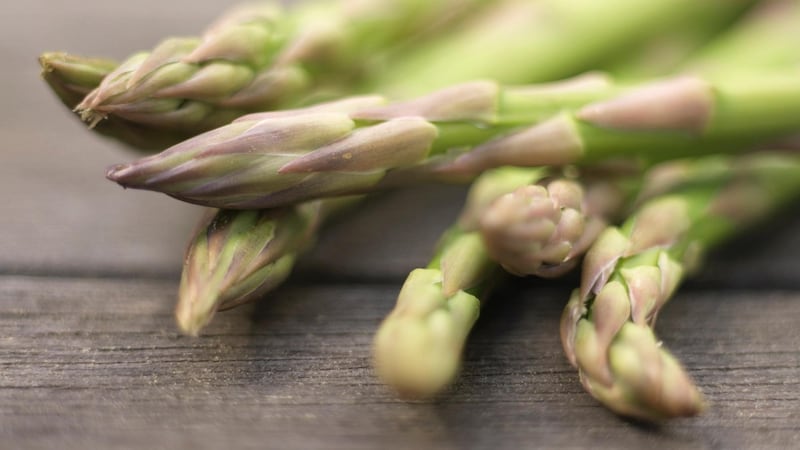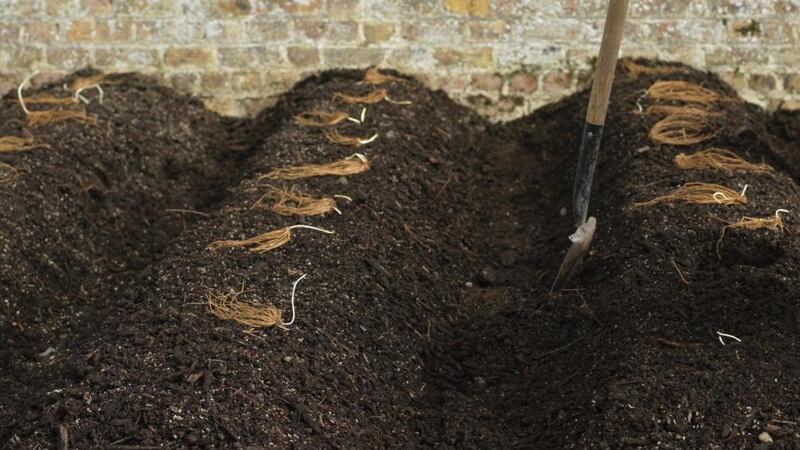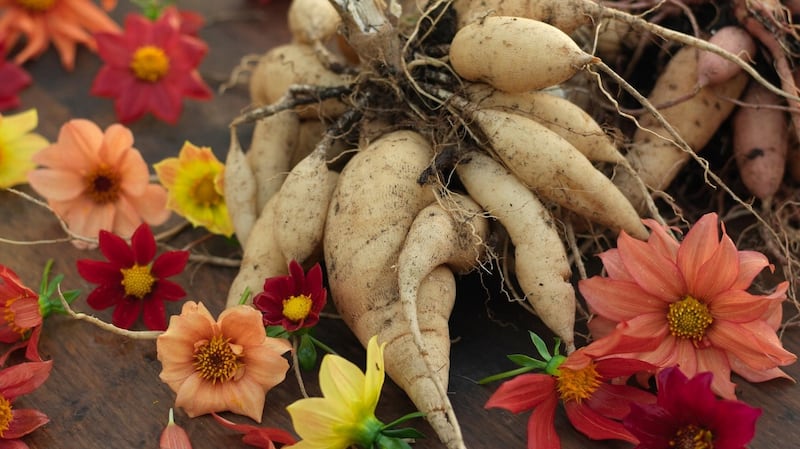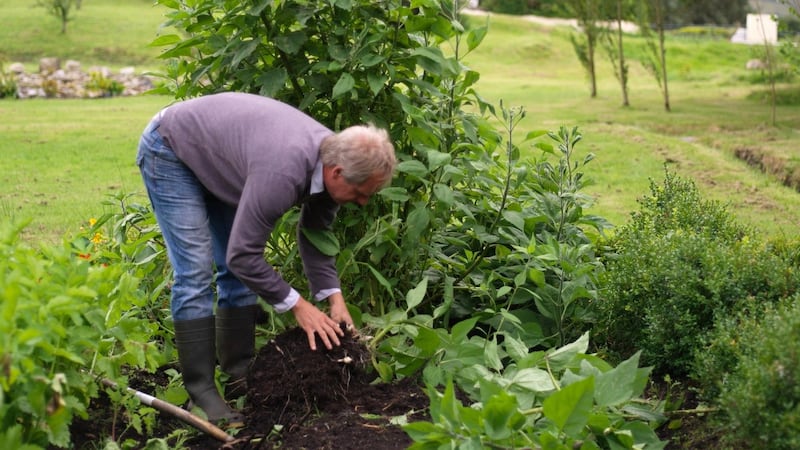If you like growing your own food, then you’ll know all too well that April-May is the busiest time of the growing year, requiring Irish kitchen gardeners to perform a frantic balancing act of sowing, planting, hoeing and weeding as we race to get seed and young transplants into the ground.
Exhausting and exhilarating in equal measures, much of the hard work lies in the fact that, unlike traditional shrubberies or flowerbeds, a typical Irish veg patch is filled with a range of short-lived annual plants that must be sown afresh each spring. Cabbage. Beetroot. Carrots. Parsnips. Lettuce. Onions. Peas . . . The list is long, while we all have only so much window/ glasshouse space in which to coax new seedlings into early growth or to nurse the more frost-tender kinds along until temperatures rise. All of which begs the question of why we don’t grow far more of the hardy perennial kinds that, once planted, will keep on giving for many years to come.
Asparagus
An obvious example is asparagus, whose succulent, delicious spears will soon begin pushing up through the ground in some lucky (and far-thinking) Irish gardeners’ plots. Give the plants the right conditions (a rich, weed-free, moisture-retentive but well-drained soil in full sun), and they will be productive not just for several years but for several decades, providing you with a six to eight-week long harvest of their oh-so-tasty, health-enhancing spears every spring. Not bad for a few hours work.

Artichokes
Another is the Jerusalem artichoke (Helianthus tuberosus), whose knobbly edible tubers can be harvested from late autumn right through the winter months to use in soups or roasted, baked or even chipped. High-yielding, tolerant of a wide range of soils and extremely easy to grow, this plant is best in a sunny, out-of-the-way corner that it can make its own and where its considerable height will not be a problem.
Other than its occasionally unfortunate effect on the human digestive system (the clue lies in its nickname, 'fartichokes'), the Jerusalem artichoke's only downside is its tendency to become invasive. To keep it in check, make sure to harvest most of the flavoursome tubers every year, leaving just a small handful behind in the ground to re-sprout the following spring. Spring is also the time to plant the tubers, which are available to order from Irish specialist online suppliers Quickcrop (quickcrop.ie ).
While it belongs to an entirely different genus of plants, the perennial globe artichoke (Cynara scolymus) is similarly space-hogging. Forming a tall, statuesque clump of architectural, silver-grey foliage that looks just as much at home in a flower border as it does in an allotment, its delicious, edible flowerheads are produced throughout the summer months. Best bought as young pot-grown plants for transplanting into the ground in spring, it likes a rich, moist but well-drained soil in full sun and should be cut back hard every autumn. Recommended varieties include ‘Green Globe’ ’Imperial Star’ and the especially ornamental ‘Violetta de Chioggia’.

Lesser-known perennials
All these obvious examples aside, there’s a host of lesser-known perennial vegetables that will grow very happily in Irish kitchen gardens and allotments with the minimum amount of fuss and bother. Many come from the brassica or cabbage family including various different kinds of perennial or perpetual kales easily propagated from cuttings. My own perennial kale plants came to me this way via a gardening friend and are descendants of plants grown in the historic kitchen gardens of Glin Castle in Co Limerick.
You can also buy young rooted cuttings of the varieties known as 'D'Aubenton's Kale (including a rare variegated type) and 'Taunton's Perennial' from specialist nurseries such as Pennard Plants (pennardplants.com). Impressively productive and easy to grow, just a couple of plants are enough to keep an average family supplied in the tasty leaves, which are rich in important nutrients and delicious added to a stir-fry, salad or smoothie, or simply sautéed or steamed .
Other perennial brassicas include sea kale (Crambe maritima), and the plant best known as nine-star broccoli (its Latin name, Brassica oleracea botrytis asparagoides, doesn't trip quite as easily off the tongue). The latter produces its delicious, cauliflower-type florets from February-May, making it a great choice for filling the awkward "hungry gap" that so many kitchen gardeners struggle with in springtime. Seed, which is available from Cork-based organic seed producers, Brown Envelope Seeds (brown envelopeseeds.com), should be sown this month.

Onion family
The onion or allium family also includes plenty of tasty additions to the perennial vegetable garden. Examples include the pretty, shade-tolerant Allium triquetrum, commonly known as the three-cornered leek or angled onion, perennial scallions (Allium fistulosum), garlic chives (Allium tuberosum), the ever-ready onion (Allium cepa perutile) and the plant known as Babington’s Leek, which can be found growing in the wild in parts of Connemara and whose young leaves add an excellent flavour to stews, soups and salads
All these aside, a host of South American tuberous perennial plants are becoming increasingly popular with a new generation of experimental, environmentally minded Irish kitchen gardeners including dahlias, mashua (Tropaeolum tuberosum), oca (Oxalis tuberosa), maca (Lepidium meyenii), and yacon (Smallanthus sonchifolius).
Perennial vegetables once commonly grown in medieval gardens are also being rediscovered including the leafy perennial vegetable known as good King Henry (Chenopodium bonus-henricus) and skirret (think of a nutty-flavoured cross between a parsnip and a carrot).
Websites
To find out more about how to grow these and many others, check out incrediblevegetables.co.uk, the website of perennial vegetable specialist Mandy Barber and Julien Skinner; perennialsolutions.org, the official website of the well-known author, permaculturist and perennial vegetable expert Eric Tonsmeier; UK plant-lover Rhizowen's blog at radix4roots.blogspot.com; pfaf.org.uk, website of the ecological charity Plants For a Future Database; and agroforestry.co.uk , the website of forest gardener Martin Crawford. Some of these also offer small amounts of seed/ young transplants of hard-to-find varieties as does the UK-specialist nursery Edulis (edulis.co.uk)

This week in the garden
Public gardens
While April is always a very busy month in the garden, it's particularly so this year as nature rushes to catch up after last month's harsh weather. With so much needing to be done, it's easy to feel under pressure but take a moment to sit back and enjoy what is one of the loveliest times of the Irish gardening year. Many great Irish gardens are also re-opening to the public at this time of year. For more details, check out the website of Gardens of Ireland Trust (gardensofireland.org) for its directory of Irish gardens open to the public. The website of The Irish Garden magazine (garden.ie) also contains an extensive guide to over 300 Irish gardens that open to visitors.
Magnolias
Magnolias are in magnificent bloom in many Irish gardens while April is also the best time to plant these hardy flowering shrubs, which typically like a moist but well-drained acidic soil in full sun or light shade. Varieties/ species suitable for smaller gardens include the pink-flowering Magnolia ‘Leonard Messel’ (this will also grow happily in an alkaline soil) and Magnolia stellata (white, star-shaped flowers).
Seedlings
Pots of young seedlings grow very quickly at this time of year and unless carefully pricked out into cell-trays or modules, will quickly begin to compete with each other for space, light and nutrients. Always handle young seedling very gently by the leaves when pricking them out to avoid damage to their vulnerable stems. It’s also best to store bags of seed compost indoors for a few days before using it to take the chill off it and prevent young seedlings’ root systems from being shocked. If you forget or don’t have time to do so, then pouring a little warm water over it will help a lot.

Dates for your diary
Sunday, April 22nd: Fota House & Gardens Spring Show, Carrigtwohill, Co Cork, see fotahouse.rezgo.com
Tuesday, April 24th (8pm): Foxrock Parish Pastoral Centre, 18 Kill Lane, Dublin 18, 'The Restoration of the Salutation Garden', a talk by its head gardener, Steve Edney, on behalf of Foxrock & District Gardening Club, see foxrockgardenclub
Saturday, April 28th (1.30-4pm): Cabinteely Community School, Johnstown Rd, Cabinteely, Dublin 18. Alpine Garden Society Dublin Group Annual Show with exhibition plants, plant sales, practical demonstrations and refreshments, admission €3, see alpinegardensociety.ie
Saturday, April 28th (10.30am to 1pm): RHSI Spring Plant Sale at Laurelmere Cottage, Marlay Park, Rathfarnham. Plant donations accepted Friday 10.30am to 1pm and Saturday from 9am.
Sunday, April 29th: Clare Garden Festival, Ennis, Co Clare, with plant sales, demos and guest speakers including garden designer Tim Austen, organic grower Jim Cronin, gardener and writer Mary Keenan, horticultural therapist Fiann Ó Nuallain and community garden expert Brid Hedderman, claregardenfestival.com













